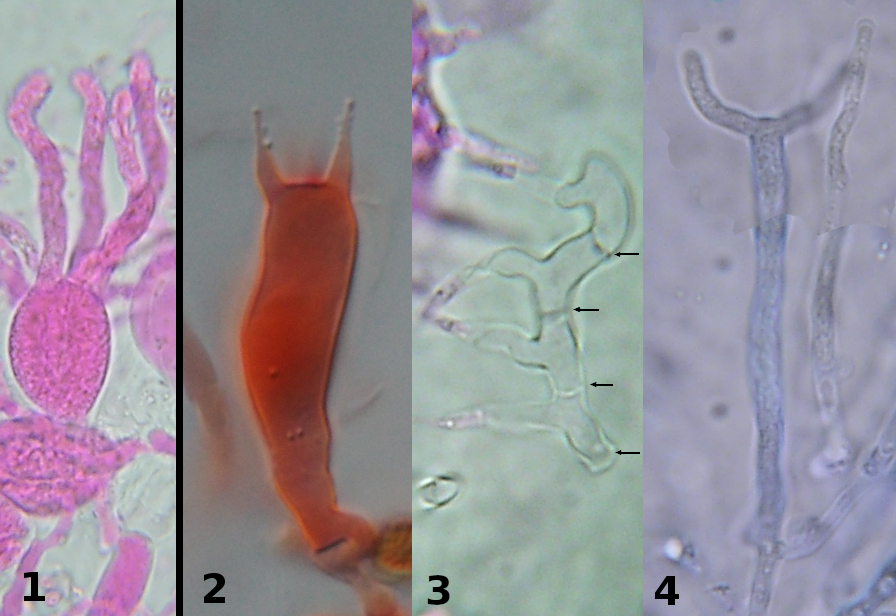DISCUSSION OF THE BASIDIOMYCOTA
To a naturalist viewing fungi in the field there would hardly be any reason to suspect the various Basidiomycota to be related to one another. Some produce large fleshy fruiting bodies, others cause disfiguring diseases of plants without any obvious fruiting bodies and some are barely visible at all. However, careful study of their life histories and close examination with a microscope shows that all produce basidia at some time in their lives. The basidia themselves vary considerably but always produce external spores, and these are mostly four in number or, more rarely, in multiples of four.
Three subphyla of Basidiomycota are generally recognized: the Pucciniomycotina, the Ustilaginomycotina and the Agaricomycotina. In the older literature this would have been presented as the rust fungi, the smut fungi and the fleshy fungi, or even as two groups, the Heterobasidiomycetes and the Homobasidiomycetes. Although these older groupings certainly relate in many repects to the newer ones, the use of modern genetic techniques have revealed a rather more complicated picture. Using these techniques it is possible to assign almost any fungus to one of the three modern subphyla; but it is more difficult to do this on the basis of features we can observe.
Some terminology
Although it is possible, at least roughly, to define the three subphyla of Basidiomycota this requires the introduction of some new concepts and terms.
Basidium types
Cruciate basidium (Figure 1)
- A type of basidium that is ellipsoidal to spherical and separated into two or four cells by the production of septa. The septa are more or less parallel to the long axis of the basidium and at right angles to each other. The easiet way to image such a basidium is by comparison to an orange having only four sections. In Figure 1 the round shape and long sterigmata are typical, but the septa cannot be seen. A more detailed illustration of cruciate basidia is presented in our discussion of Tremella encephala
Holobasidium (Figure 2)
- A type of basidium that is elongated and non-septate. The sterigmata are two to eight in number and are relatively short.
Phragmobasidium (Figure 3)
- A type of basidium that is elongated and separated into two or four cells by the production of septa. The septa are always at right angles to the long axis of the basidium. In Figure 3 the septa are indicated by black arrows. The sterigmata can be seen projecting off to the left.
Tuning fork basidium (Figure 4)
- A type of basidium that is elongated and non-septate. The sterigmata are produced in pairs and are greatly elongated, giving the basidium the appearance of a tuning fork. Typical of the class Dacrymycetes.

Dikaryotic state
Condition in the Dikary where cells contain two compatible nuclei and the the binuceate condition is maintained during cell division. See the discussion of reproduction in the Dikarya for further information.
Monokaryotic state
Condition in the Dikary where cells contain a single nucleus. See the discussion of reproduction in the Dikarya for further information.
Sterigmata (sing. sterigma)
Horn-like extensions from the basidium on which basidiospores are produced.
Teliospore
At a very early stage in its development at basidium may become thick-walled and go into a form of dormancy. This thick-walled cell, usually containing a diploid nucleus, may resemble a spore and may even become detached and disseminated to a new location. Later, usually at the beginning of a new growing season, the nucleus undergoes meiosis and the basidium completes its development. Some teliospores are multicellular and produce a basidium from each cell.
The subphyla
Pucciniomycotina - the rust fungi and their allies
- A large and diverse group of fungi living as parasites on plants, fungi or insects. A few appear to be saprotrophs. Many produce teliospores. Nearly all have phragmobasidia. The vast majority of species belong to the Pucciniales or rust fungi, a huge group of plant parasites. The Septobasidiales, a smaller group, are parasitic on scale insects.
Ustilaginomycotina - the smut fungi and their allies
- All plant parasites in the dikaryotic state but living as saprotrophs in the monokaryotic state. Many produce teliospores. Most, except the Exobasidiales, have phragmobasidia. Most species produce darkly coloured masses of teliospores on the host plant and are called smuts.
Agaricomycotina - the mushrooms and their allies
- Mostly not parasitic on plants although a few are fungal parasites. Most living as saprotrophs on wood or other organic materials or forming mycorrhizae with trees and woody shrubs. Teliospores not produced. Basidia various but only rarely as phragmobasidia. Nearly all Basidiomycota producing conspicuous fruiting bodies belong here.